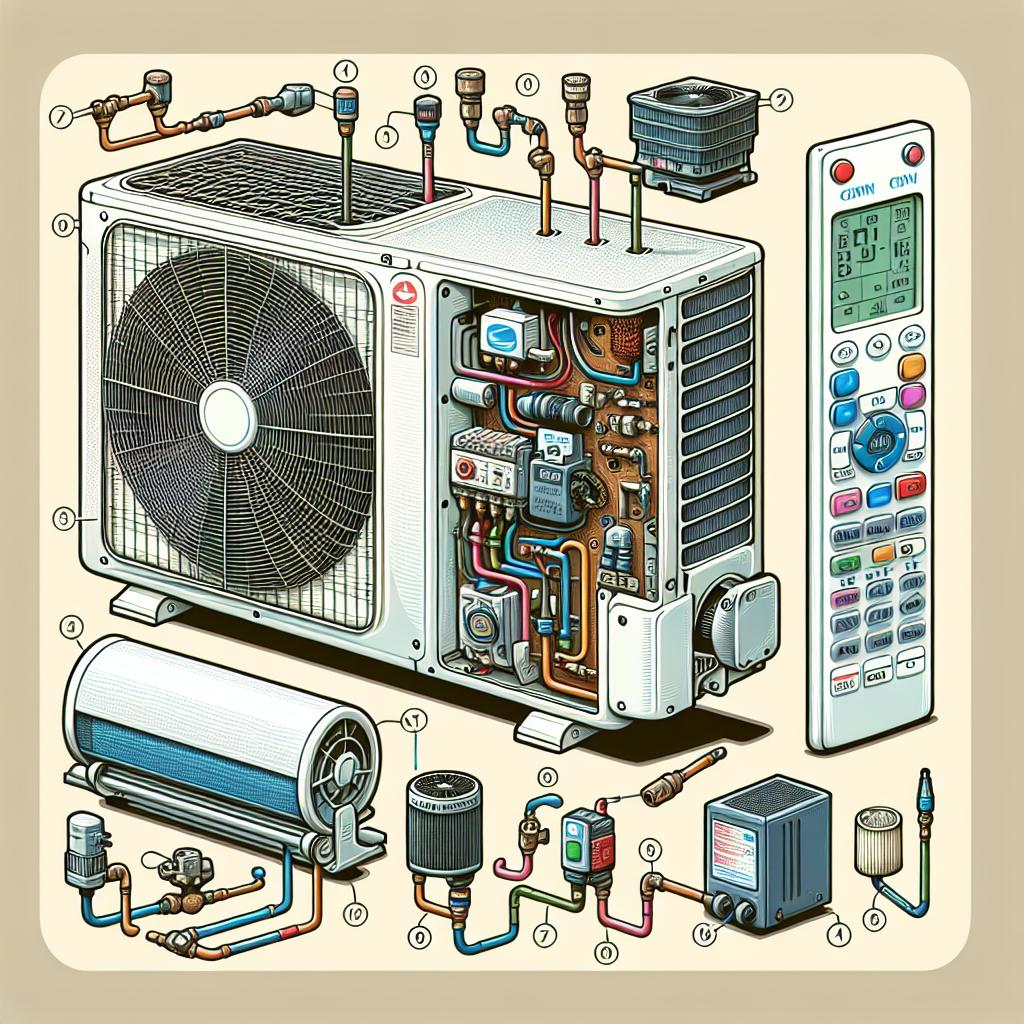The Ultimate Guide to Maintaining Mini Split AC Systems in Restaurants
As the sizzling pans and aromatic spices of culinary creativity fill the air, there’s another unsung hero quietly working behind the scenes: the mini split air conditioning system. For restaurants, these compact yet powerful units are not just about temperature control; they play a crucial role in ensuring the comfort of both patrons and staff alike. However, like any sophisticated piece of equipment, they require diligent care and maintenance to operate at their best. In this comprehensive guide, we’ll explore the essential practices and tips for maintaining mini split AC systems, helping you keep the ambiance in your restaurant as exceptional as your dishes. Whether you’re a seasoned restaurateur or embarking on a new culinary venture, understanding the intricacies of these systems will position you for success in the competitive hospitality landscape. Let’s dive in and discover how proper maintenance can elevate your dining experience while enhancing operational efficiency.
Understanding the Importance of Mini Split AC Systems in Restaurant Environments
In the fast-paced environment of a restaurant, maintaining a comfortable climate is essential not only for guest satisfaction but also for employee productivity. Mini split AC systems offer the flexibility and efficiency needed to control temperatures in various zones without disrupting the entire establishment. By effectively regulating indoor climates, these systems help mitigate the heat generated by kitchen equipment while providing a refreshing escape for diners. Furthermore, mini splits are appreciated for their whisper-quiet operation, ensuring that the ambiance of the restaurant remains inviting and enjoyable.
Another significant advantage of these systems is their energy efficiency, which is crucial for managing operational costs in restaurants. Unlike traditional HVAC systems that cool entire buildings, mini splits allow owners to cool specific areas based on occupancy and need. The benefits of this include:
- Reduced energy consumption
- Customizable climate control for dining areas and kitchens
- Lower utility bills, enhancing overall profitability
Adopting mini split AC systems can be a smart investment for restaurant owners looking to improve the dining experience while simultaneously enhancing energy savings and sustainability efforts.

Essential Components and Features of Mini Split AC Units
Mini split AC units are composed of several essential components that work in harmony to provide efficient cooling and heating solutions. The indoor unit serves as the primary interface, designed to deliver controlled air directly into the space, while the outdoor unit houses the compressor and condenser, playing a vital role in the heat exchange process. A key feature is the refrigerant lines, which connect the two units, facilitating the flow of refrigerant necessary for cooling. Additionally, these systems often include inverter technology, allowing for precise control of compressor speed, which enhances energy efficiency and maintains the desired temperature with minimal deviations.
Another notable feature of mini split systems is their multi-zone capability, which enables multiple indoor units to connect to a single outdoor unit, effectively cooling or heating different areas of a restaurant simultaneously. This setup fosters a customizable climate experience across various dining spaces. Maintenance-friendly features such as filter access, easy-to-clean coils, and self-diagnosis functions simplify upkeep, making it manageable for restaurant staff to ensure the system remains in optimal condition. The integration of smart technology in many modern units allows for easy monitoring and adjustment of temperature settings, further optimizing energy consumption and comfort for both employees and guests.

Best Practices for Routine Maintenance and Cleaning
Ensuring the longevity and efficiency of mini split AC systems in restaurants requires a proactive approach to routine maintenance and cleaning. Start by establishing a regular maintenance schedule that includes tasks such as filter cleaning or replacement, which should be performed every 1-3 months, depending on the dust levels in your restaurant. Additionally, inspect the outdoor unit regularly to remove any debris, leaves, or obstructions that could hinder airflow. Here are some essential maintenance tasks to include:
- Cleansing the condenser coils – This should be done twice a year to maximize heat exchange efficiency.
- Checking the refrigerant levels – Low refrigerant can indicate leaks that need prompt addressing.
- Inspecting the drainage system – Ensure that the drain lines are clear to prevent water damage and mold growth.
In addition to these tasks, consider documenting your maintenance activities in a log to track your efforts over time. This will not only help in maintaining operational efficiency but also in identifying any recurring issues. Implementing a cleaning protocol is also crucial—establish guidelines for the staff that include regular wipe-downs of indoor units to eliminate dust buildup. The following table summarizes the recommended frequency for key maintenance tasks:
| Maintenance Task | Frequency |
|---|---|
| Filter Cleaning/Replacement | 1-3 Months |
| Condenser Coil Cleaning | Every 6 Months |
| Refrigerant Level Check | Annually |
| Drain Line Inspection | Every 3 Months |

Troubleshooting Common Issues and Ensuring Optimal Performance
When faced with issues in mini split AC systems, it’s crucial to identify common problems to maintain comfort and energy efficiency in your restaurant. Inadequate cooling is often a result of dirty air filters or blocked ducts. Regularly cleaning or replacing filters can drastically improve airflow and overall efficiency. Another frequent problem is refrigerant leaks, which not only degrade performance but can also be harmful to customers and staff. Check for signs like ice on the coils or hissing sounds, and consult a professional to fix any leaks promptly.
To ensure your mini split AC system operates at peak performance, consider implementing a routine checklist that includes:
- Inspecting the outdoor unit for debris and obstructions
- Checking the settings on the thermostat
- Monitoring energy consumption for any unexpected spikes
Additionally, regular maintenance should involve a professional technician who can perform a comprehensive system tune-up. Their expertise will help keep the system running smoothly, extending its lifespan and enhancing the comfort of your restaurant.
Q&A
The Ultimate Guide to Maintaining Mini Split AC Systems in Restaurants: Q&A
Q1: What is a mini split AC system, and why is it beneficial for restaurants?
A: A mini split AC system is a type of air conditioning that features an outdoor compressor unit and one or more indoor air-handling units, separated by refrigerant lines. For restaurants, the benefits are numerous: they provide flexible zoning options, operate quietly, and allow for energy-efficient cooling, which is vital in maintaining a comfortable dining atmosphere even during peak hours.
Q2: How often should I perform maintenance on my mini split AC system?
A: Regular maintenance for mini split AC systems is recommended at least twice a year—ideally before the peak usage seasons of summer and winter. This ensures that your system is operating efficiently, reducing the risk of breakdowns when your restaurant is busiest.
Q3: What are the key components of a mini split AC system that need regular maintenance?
A: Key components to focus on include the filters, coils, drain lines, and the outdoor unit. Cleaning or replacing filters and coils regularly ensures optimal airflow and efficiency. Additionally, clearing the drain lines helps prevent water damage and potential mold growth.
Q4: Can staff perform basic maintenance, or should it be left to professionals?
A: While basic maintenance tasks like cleaning filters can be handled by your staff, it is advisable to hire professionals for more intricate tasks. This includes checking refrigerant levels, cleaning coils thoroughly, and troubleshooting any uncommon issues to ensure everything runs smoothly and efficiently.
Q5: What are the common signs that my mini split AC system needs attention?
A: Look out for signs such as unusual noises, fluctuating temperatures, increased energy bills, or a musty smell coming from the indoor unit. Any of these could indicate that your system is not functioning optimally and may require a professional inspection.
Q6: Is it possible to increase the efficiency of my mini split system?
A: Absolutely! You can increase efficiency by ensuring proper insulation of the restaurant, regularly cleaning filters, and keeping the outdoor unit clear of debris. Additionally, using programmable thermostats can help maintain consistent temperatures without excessive energy use.
Q7: What should I expect from a professional maintenance service?
A: A professional maintenance service should include a comprehensive inspection of your system, cleaning of the coils and filters, checking refrigerant levels, evaluating the ductwork (if applicable), and assessing electrical components. They should also offer insights on potential upgrades or adjustments to boost performance.
Q8: How can I ensure my mini split AC system lasts longer?
A: To extend the lifespan of your mini split AC system, prioritize regular maintenance, address issues promptly, and consider investing in quality installation from reputable technicians. Educating your staff about proper usage can also prevent unnecessary wear and tear.
Q9: Are there any specific regulatory requirements for AC systems in restaurants?
A: Yes, depending on your location, there may be specific health and safety regulations concerning ventilation and air conditioning systems in restaurants. It’s crucial to familiarize yourself with these regulations to ensure compliance and maintain a safe environment for staff and customers.
Q10: What is the takeaway regarding mini split AC maintenance in restaurants?
A: The key takeaway is that proactive and regular maintenance of your mini split AC system is vital for ensuring a comfortable dining experience, reducing energy consumption, and extending the lifespan of your investment. Prioritize maintenance as part of your restaurant’s operational strategy to enjoy the benefits of clean, efficient air conditioning all year round.
Closing Remarks
ensuring optimal performance of mini split AC systems in restaurants is crucial for both customer satisfaction and operational efficiency. By following the guidelines outlined in this ultimate guide—regular maintenance, timely professional check-ups, and understanding the unique demands of a restaurant environment—you can create a comfortable atmosphere that keeps patrons coming back for more. Just as a well-prepared dish speaks volumes about a restaurant’s commitment to quality, a well-maintained air conditioning system reflects dedication to guest comfort. So take these insights, arm yourself with knowledge, and transform your mini split AC into the unsung hero of your culinary establishment. After all, in the world of fine dining, every detail counts—from the seasoning of a dish to the temperature of the air. Here’s to a cooler, more inviting restaurant space!

